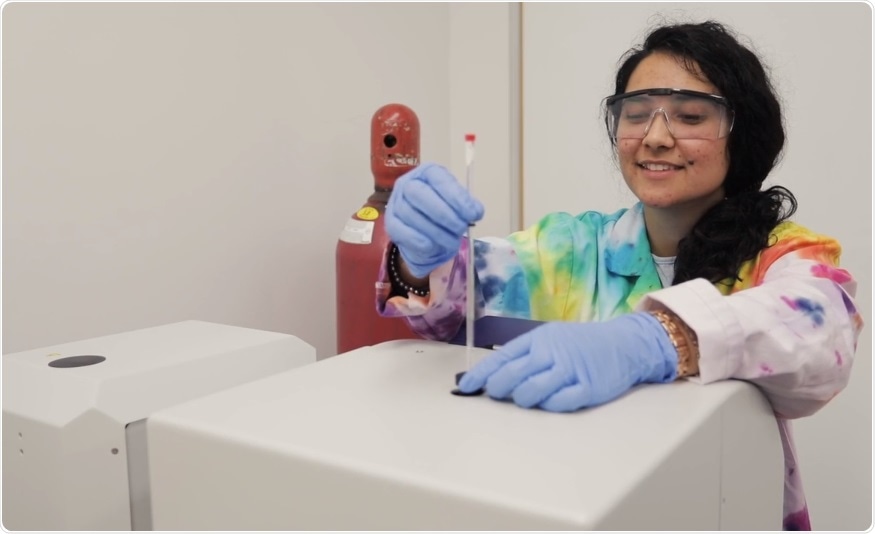Please give an introduction to the roles you carry out at Cape Breton University.
I'm a Senior Chemistry Lab instructor at Cape Breton University, as well as a Transmission Electron Microscope technician.
I instruct second, third and fourth year labs that complement the courses that we offer our to our undergraduate chemistry students. The lab sessions that I currently teach are in analytical and inorganic chemistry, but I have also been involved with lab sessions for physical , organic, and biochemistry lab components
At Cape Breton University, we have two instruments that have been supplied by Bruker. One is a 400 megahertz NMR spectrometer, and the second instrument is the micro electron paramagnetic resonance (EPR) spectrometer. We are very fortunate to have access to the microESR through the Verschuren Centre and the research group of Dr Xu (Shine) Zhang, Research Chair in Applied Nanotechnology at CBU. Both of these instruments are available for use by our undergraduate students.
In the Classroom with Magnetic Resonance
In the Classroom with Magnetic Resonance from AZoNetwork on Vimeo.
The nuclear magnetic resonance spectrometer is specifically designed for teaching and research at the university, the students get hands on experience in looking at determining the structures of different types of molecules that they synthesize in lab.
Why is it important to introduce students to these instruments early on?
At Cape Breton University, we have a big advantage over larger institutions as we offer our students small class sizes. As a result of this, students in second, third and fourth year chemistry labs and courses have valuable, hands on experience with modern instrumentation. As our classes have fewer students in them, we have the ability to take the labs down to the instruments where students can learn how they operate. They get to run their samples themselves, and process data for compounds that they have synthesized from their own experiments in the lab. This is not something you often see at larger institutions.
How are students introduced to such machinery? How do instruments form part of that learning?
Students at Cape Breton University are introduced to instrumentation as early as first year. Once students enter the second year of study in their programs at CBU, they obtain hands on experience with more advanced analytical instrumentation. This includes not only the NMR and micro ESR, but AA, GCMS, FTIR, and UPLCMSMS. This experience will be invaluable to them as they go on in their chemistry careers.
How easy is it for students to use and maintain the Micro ESR?
The EPR spectrometer is an instrument that is new to the students, and it provides a new technique for our students to learn. It is located in our Verschuren Center, in the research group of Dr Xu Zhang, Research Chair in Applied Nanotechnology at CBU. where currently, I use it for teaching labs which involve looking at free radical molecules. EPR is important for studies involving free radicals, as these compounds cannot be studied using NMR.

The microESR is used for both teaching and research. It's very easy for our students to use and it also helps students to understand the principles of ESR and how it’s complimentary to NMR. It takes students no more than five minutes to understand the basic operation of the instrument, with data collection and interpretation being simple and quick for the students to carry out, too. It's very easy software to work with, and it provides useful information to the students after the lab is complete.
The system itself is very easily maintained. It does not require liquid cryogen fills, it's a very portable instrument that's easy to move from one location to another and it doesn’t need a special set up which means that it was very easy to install. Overall, we’re pleased to have the Micro ESR available for our experiments in our undergraduate labs and it's a very useful addition to the instrumentation at CBU.
Is there a reason you chose Bruker instruments over those offered by other companies?
Both of the Bruker instruments, the NMR and microEPR spectrometer that our students are trained upon, as part of their undergraduate programs, were chosen for several very important reasons. First, upon installation Bruker provided excellent training opportunities for our users so that we know all of the options that are available on our systems.
Secondly, Bruker has an excellent service support system. If we have any issues with our instrumentation, we simply pick up the phone and call the service number, where we're provided with the help that we need very quickly and clearly. This is one of the features that makes Bruker stand out as spectrometer provider and that’s why Buker was our instrument of choice.
When it comes to experience with NMR and ESR, it must be incredibly important for student development. How does this help students get ahead in their career once they leave university?
Hands on experience for our students with different types of analytical instrumentation, specifically the NMR and EPR, provide our students with the ability to use complex equipment without fear of breaking it. They pick up the skills necessary to run this instrumentation, prepare their samples, carry out the analysis, collect the data and interpret their data, and these are all hands-on skills that will enable them to excel at future chemistry careers.
About Judy MacInnis
 Judy MacInnis is a Senior Chemistry Lab instructor and Transmission electron microscope technician at Cape Breton University, in Sydney Nova Scotia. During her time at CBU part of her job has included introducing students to the use and maintenance required for various analytical instruments within undergraduate chemistry program.
Judy MacInnis is a Senior Chemistry Lab instructor and Transmission electron microscope technician at Cape Breton University, in Sydney Nova Scotia. During her time at CBU part of her job has included introducing students to the use and maintenance required for various analytical instruments within undergraduate chemistry program.
When she is not working with analytical instrumentation, she is also very active in chemistry outreach in the local community. She was awarded the CBU Exceptional Lab/Clinical Instructor Award in 2014. Judy holds a Master's degree in Chemistry from St.F.X University in Antigonish N.S. as well as a B. Ed from Mount Allison University in Sackville NB.
About Bruker BioSpin Group
The Bruker BioSpin Group designs, manufactures, and distributes advanced scientific instruments based on magnetic resonance and preclinical imaging technologies. These include our industry-leading NMR and EPR spectrometers, as well as imaging systems utilizing MRI, PET, SPECT, CT, Optical and MPI modalities. The Group also offers integrated software solutions and automation tools to support digital transformation across research and quality control environments.
Bruker BioSpin’s customers in academic, government, industrial, and pharmaceutical sectors rely on these technologies to gain detailed insights into molecular structure, dynamics, and interactions. Our solutions play a key role in structural biology, drug discovery, disease research, metabolomics, and advanced materials analysis. Recent investments in lab automation, optical imaging, and contract research services further strengthen our ability to support evolving customer needs and enable scientific innovation.